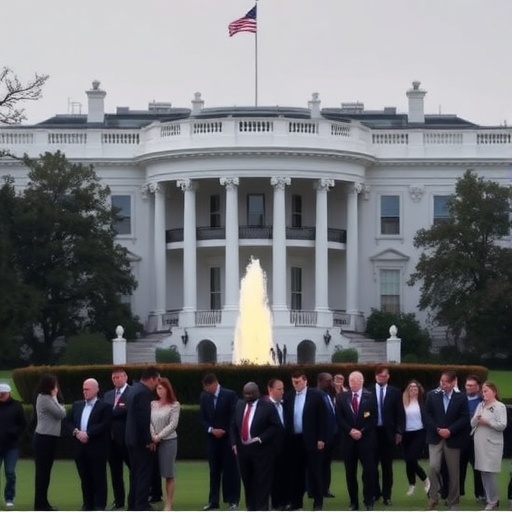White House Confirms Mass Federal Layoffs Amid Prolonged Government Shutdown: Thousands of Jobs at Risk
In a stark escalation of the ongoing government shutdown, the White House has officially confirmed that mass layoffs are underway across the federal workforce. The Office of Management and Budget (OMB) announced on Friday that multiple agencies have begun issuing reduction-in-force (RIF) notices, signaling the start of substantial workforce reductions as funding dries up. This move affects tens of thousands of federal employees, many of whom have already endured weeks without pay, and could reshape the landscape of public service in the United States.
The announcement comes as the shutdown, now in its 35th day, surpasses previous records in duration and economic impact. With Congress deadlocked over budget disputes, particularly around immigration and border security funding, the federal government is resorting to emergency measures to cut costs. “These actions are regrettable but necessary to preserve core functions,” an OMB spokesperson stated in a press release. The implications ripple far beyond Washington, D.C., touching families, communities, and the broader economy.
OMB Directs Agencies to Implement Immediate RIF Procedures
The White House‘s Office of Management and Budget (OMB) has taken the lead in orchestrating the layoffs, issuing directives that mandate agencies to prioritize essential services while trimming non-critical staff. Under federal guidelines, RIF procedures allow for the permanent separation of employees when funding lapses extend beyond temporary furloughs. According to the OMB’s latest memo, obtained by this news outlet, agencies must submit detailed RIF plans by the end of the month, targeting a 10-15% reduction in their respective workforces.
This isn’t the first time such measures have been discussed during shutdowns, but the scale here is unprecedented. The Department of Defense, which employs over 700,000 civilians, has already notified 20,000 workers of potential layoffs, focusing on administrative and support roles. Similarly, the Department of Health and Human Services (HHS) is preparing to issue notices to 15,000 staff members involved in research and regulatory oversight. “We’re talking about real people—scientists, analysts, and administrators—who built their careers serving the public,” said Sarah Jenkins, a policy expert at the Brookings Institution. “The OMB’s push for rapid implementation underscores the desperation in Washington.”
Statistics from past shutdowns paint a grim picture. During the 2013 shutdown, which lasted 16 days, temporary furloughs affected 800,000 workers, costing the economy $24 billion. This time, with the government shutdown stretching into its fifth week, projections from the Congressional Budget Office estimate losses could exceed $50 billion, including indirect effects from unpaid federal workers. Layoffs add a permanent layer of uncertainty, as RIF’d employees face a competitive rehire process that can take months or years.
Federal Workers Face Uncertain Futures in Key Sectors
Across the federal workforce, the layoffs are hitting hardest in sectors vital to national security, public health, and environmental protection. The Environmental Protection Agency (EPA), for instance, has furloughed 95% of its staff since the shutdown began, and now faces laying off 5,000 permanent employees focused on climate research and pollution enforcement. “Our work on clean air standards is grinding to a halt,” lamented EPA veteran Mark Thompson in an interview. “These aren’t just jobs; they’re missions that protect American lives.”
In the realm of national defense, the impacts are equally profound. The Pentagon’s civilian workforce, already strained by global commitments, is seeing RIF notices distributed to logistics and procurement teams. A leaked internal email from the Department of Defense revealed that up to 30,000 positions could be eliminated if the shutdown persists another two weeks. This comes at a time when military readiness is under scrutiny, with reports of delayed maintenance on ships and aircraft due to unpaid contractors.
Public health agencies aren’t spared either. The Centers for Disease Control and Prevention (CDC) has warned that ongoing layoffs could impair responses to emerging health threats, such as flu outbreaks or potential pandemics. With 12,000 employees at risk, the CDC’s ability to monitor diseases globally might suffer long-term setbacks. Federal unions, including the American Federation of Government Employees (AFGE), have mobilized, filing lawsuits against the White House to halt the RIF process. “This is a betrayal of the civil service,” AFGE President Everett Kelley declared in a statement. “Workers deserve stability, not this chaos born from political gridlock.”
The human element is heartbreaking. Stories from affected employees flood social media and news inboxes. Lisa Ramirez, a 15-year veteran at the Department of Veterans Affairs (VA), shared her plight: “I’ve cared for our heroes, but now my family is the one in crisis. No paycheck, and now the threat of permanent job loss—it’s devastating.” The VA, serving millions of veterans, anticipates 25,000 layoffs, potentially delaying benefits processing and healthcare services for those who served the nation.
Historical Precedents Amplify Shutdown’s Layoff Fears
The current government shutdown draws uncomfortable parallels to historical crises that led to federal workforce cuts. In 1995-1996, a 21-day shutdown under President Clinton prompted preliminary RIF discussions, though none materialized on this scale. More recently, the 2018-2019 shutdown, the longest at 35 days, furloughed 800,000 workers but stopped short of mass layoffs due to bipartisan intervention. This time, the White House’s firm stance suggests a different calculus.
OMB data highlights the evolution of shutdown responses. From 1976 to 2019, there were 20 funding gaps, but none exceeded 21 days until recently. The federal workforce has grown modestly to 2.1 million civilians, but budget constraints have kept hiring flat. During prolonged lapses, agencies must draw from contingency funds, which the OMB reports are now depleted. “History shows that shutdowns erode trust in government,” noted historian Dr. Elena Vasquez from Georgetown University. “Layoffs could accelerate a brain drain, with skilled workers fleeing to the private sector.”
Economically, the stakes are high. The U.S. Chamber of Commerce estimates that each week of shutdown costs $1.5 billion in lost productivity from the federal workforce alone. Layoffs compound this, as displaced workers draw unemployment benefits—projected at $2 billion over the next quarter—while stimulating local economies less than their salaries did. Small businesses near federal installations, from D.C. delis to Virginia contractors, report 20-30% revenue drops, per a National Federation of Independent Business survey.
Politically, the White House faces backlash. Polls from Gallup show approval for handling the shutdown at 28%, with independents particularly outraged over the layoffs. Bipartisan calls for negotiation grow louder, but entrenched positions on spending cuts versus increased funding persist.
Experts Predict Widespread Economic and Social Fallout
As the dust settles on the initial RIF notices, experts are sounding alarms about the broader fallout from these White House-sanctioned layoffs. Economists at the Federal Reserve predict a 0.5% drag on GDP growth in the first half of the year, driven by reduced consumer spending from unpaid and unemployed federal workers. “The federal workforce isn’t just a payroll; it’s an economic engine,” said Dr. Raj Patel, chief economist at Moody’s Analytics. “Layoffs here create a domino effect, hitting housing markets, retail, and even stock indices tied to government contracts.”
Socially, the impacts are uneven. Women and minorities, who comprise 45% and 35% of the federal workforce respectively, are overrepresented in administrative roles ripe for cuts. The Partnership for Public Service reports that diversity initiatives could stall, exacerbating inequalities. Mental health resources are strained, with the Employee Assistance Program seeing a 40% uptick in calls since the shutdown began.
Quotes from Capitol Hill underscore the divide. House Speaker Nancy Pelosi criticized the White House, saying, “This shutdown is a manufactured crisis, and these layoffs are its cruelest symptom.” In response, Senate Majority Leader Mitch McConnell defended fiscal restraint: “We can’t spend what we don’t have; tough choices preserve the government’s solvency.” Bipartisan talks, mediated by OMB officials, are slated for next week, but optimism is low.
Worker advocacy groups are ramping up efforts. The National Treasury Employees Union (NTEU) has launched a “Save Our Service” campaign, gathering 500,000 signatures urging Congress to act. Meanwhile, private sector recruiters report a surge in resumes from feds, with tech firms like Amazon and Google eyeing talent in cybersecurity and data analysis.
Path Forward: Negotiations and Long-Term Reforms on Horizon
Looking ahead, the end of the government shutdown hinges on delicate negotiations between the White House and Congress. OMB projections indicate that if resolved within 10 days, up to 50% of issued RIF notices could be rescinded, allowing rehiring. However, prolonged stalemate might force even deeper cuts, with the IRS and Social Security Administration next in line—potentially affecting tax refunds and benefit payments for millions.
Long-term, this crisis spotlights the need for shutdown reforms. Bipartisan bills in Congress propose automatic continuing resolutions to prevent future lapses, ensuring the federal workforce remains stable. The White House has expressed openness to such measures, but only if paired with spending caps. As families brace for uncertainty, the hope is that political will converges before irreversible damage to public service occurs.
In the coming weeks, monitoring agency updates and economic indicators will be crucial. For federal workers, resources like USAJOBS and union hotlines offer guidance on appeals and job searches. The nation watches, urging leaders to prioritize people over politics in resolving this shutdown saga.








